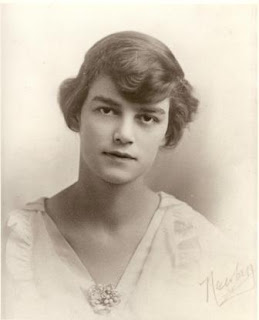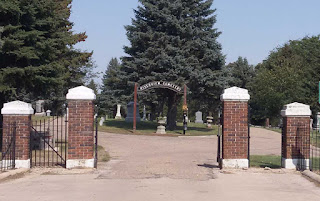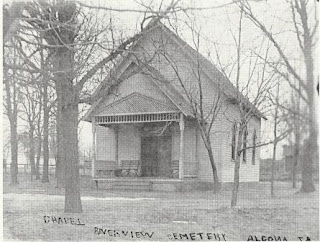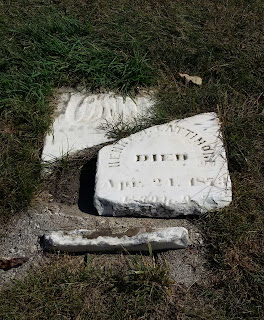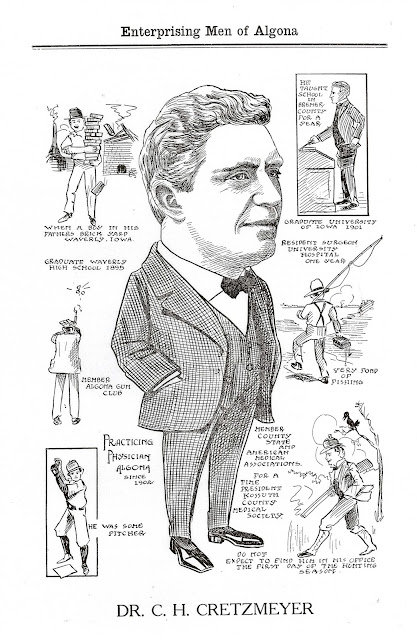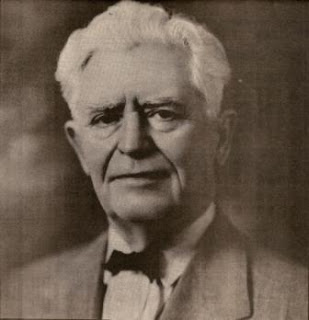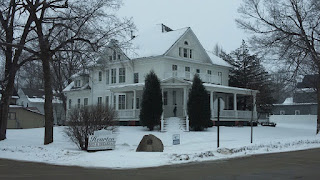 One
of the most unique homes in “Picturesque Algona” – in fact in all of Algona
even today – is the Swetting home located at 331 North Thorington Street. Looking much like an old Italian villa, it
was owned in 1900 by Ernest Volney Swetting and his wife, Bernice. The superior craftsmanship of the mason is
shown in the brick crowns over the windows and other features which give this
house so much character.
One
of the most unique homes in “Picturesque Algona” – in fact in all of Algona
even today – is the Swetting home located at 331 North Thorington Street. Looking much like an old Italian villa, it
was owned in 1900 by Ernest Volney Swetting and his wife, Bernice. The superior craftsmanship of the mason is
shown in the brick crowns over the windows and other features which give this
house so much character.E.V. SWETTING
E.
V. Swetting first came to Algona in 1878 as a school teacher. He also taught for a short time at
Estherville. His dream of becoming an
attorney was realized when he began to study the law in the offices of
Coolbaugh & Call, well-known Algona attorneys. He passed the bar in 1886 and was admitted to
practice.
That
same year he was married to Mrs. Bernice P. Johnson, a widow with a young
daughter. They lived briefly in Emmet
County, but moved permanently to Algona in 1891. By the time “Picturesque Algona” was
published in 1900, the Swettings were living in this lovely brick abode.
In
talking to its current owners, Harley and Anne Kohlhaas, I was told that their
research indicated that the structure was likely built in the late 1860s or
sometime in the 1870s. That period falls
within the time frame when the Italianate style of home was most popular in the
United States, but was certainly earlier than 1891 which is when the Swettings permanently
settled in town. I found it hard to
reconcile the difference in dates because I assumed the Swettings had built the
house (a rookie mistake). Once I
realized my error, I attacked the search with a broader mind. I was hopeful that as I researched the house,
I would be able to discover the truth.
My
first stop was at the Kossuth County courthouse. Records there revealed that Lelia E. Benham
deeded the real estate on which the house sits to E. V. Swetting on March 30,
1894. An article from the Algona
Republican published on April 4, 1894 states that “E. V. Swetting has bought the Mrs. Benham place on Thorington street
and will make it his future home. There
is a pretty and commodious brick house and four desirable lots. He got the property cheap at $1600.” A piece of the puzzle fell into place as I now
knew the house was in existence in 1894.
THE BENHAMS
So
who was Lelia Benham and how did she become owner of the house? By 1894 Mrs. Benham was a widow. Her husband, Napoleon Bonaparte “Poley” Benham had died
in May of 1890 at the age of 47 years. I
knew a little about Mr. Benham from a Civil War project that I had contributed
to for the Kossuth County Genealogical Society several years ago.
Benham
had enlisted in the 106th New York volunteers in 1862 at the age of
19. While serving under General Sheridan
at the battle of Winchester on September 19, 1864, he was shot in the right
lung while his regiment was charging a rebel battery. His obituary published in the Upper Des Moines
on May 14, 1890, states: “The bullet went in just below the collar
bone, and was not found for two weeks.
But with the indomitable grit that characterized him, he picked up his
musket and walked to the hospital three miles distant. Parts of his coat and shirt were taken from
the wound, and probably some were never found but remained to poison his
blood. In December he had recovered
sufficiently to go back to the front, where he was made a second lieutenant,
and where he served till the war closed.”
He would never truly recover from his wound.
Following
the war, Mr. Benham settled in Clayton County, Iowa, where he met and married
his wife, Lelia Benham. A short time
later he drove across the prairies with fellow veteran Adam Sawvel to Kossuth
County. Liking what he saw, he took a
homestead in Lotts Creek township and also took one for A. A. Brunson, a childhood
friend and army comrade. In 1870 he
moved his family to a sod house he had built on the property. They remained on the farm for several years
where they added a barn, but always lived in the sod house. The grasshopper plague brought their farming
venture to an end. The family then moved
to Algona where Benham became manager of Lockwood’s Store.
Knowing
that the Benhams moved to Algona in the mid-1870s gave me a further clue. I have to admit that tracking the chain of
ownership to the property in question was not easy. Legal descriptions had changed through the
years as areas of the town were platted.
The legal description used at the time the property was sold to E. V.
Swetting was not the same description used when it was purchased by the
Benhams. After several hours of
searching through courthouse records and receiving the helpful and knowledgeable
assistance of the personnel at the Assessor’s and Recorder’s offices, I was
able to determine that N.B. Benham purchased the property July 16, 1878 from
Asa C. Call. I do believe that the
property would have been unimproved at the time Benhams purchased it since Asa
Call owned mostly unimproved lots which he would sell for development.
In
1878 Benham was elected Clerk of court where he continued to serve for ten
years. At that time the office of Clerk
was an elected position. In the campaign
of 1882, the Upper Des Moines newspaper ran an editorial which came out in
favor of Benham’s competitor. The
article states, “Mr. Benham has also had
the office for four years. He is a good
man, but he is not the only good man in the county, and having held the office
two terms he has no further claim upon it.
Before taking the office he held a lucrative position in the “Dollar
Variety Store,” and is in independent circumstances, having one of the costliest residences in Algona, so that he will
hardly make the claim of being entitled to sympathy. Experience shows that it is better to change
officers once in four years at least, and this rule has usually been recognized
in this county, but, of course, Mr. Benham wants to hold onto a good thing just
as long as he can.” (Emphasis mine).
After
gathering all of this circumstantial evidence, it is my theory that this
distinctive, one-of-a-kind home was built by Napoleon and Lelia Benham in the
late 1870s following his election as Clerk of Court. This time frame corresponds with the estimated
age suggested to Harley and Anne Kohlhaas. It is unknown where the Benhams
lived when they first moved to Algona, but it had to be quite a transition
going from a sod house to a more traditional home. Moving to this brand new magnificent
structure just a few years later must have been a dream come true for its
residents.
Despite
anything in the editorial to the contrary, Benham was well liked and an
efficient public servant. His health
continued to decline, however, when the poison in his lung spread to his
neck. Leaving office in 1888, his last
two years of life until he passed away were spent as an invalid. It is mentioned in several sources that no
matter his circumstances, Poley always maintained a genial spirit and greeted
everyone with a smile and kind word. He
died May 8, 1890. His funeral was held
at the residence with a large attendance.
Following the service, a large group of Masons wearing white crepe led
the long procession which wended its way to Riverview cemetery where his body
was laid to rest. He left behind a wife,
a daughter and two sons to mourn his passing.
 |
| N.B. Benham |
THE SWETTINGS
The
house became a fine home for the Swettings as well. Both were involved in the community and the Congregational
Church. Bernice was a member of the
Woman’s Library Aid Society and enjoyed homemaking and entertaining her
friends, hosting various meetings in her home.
Besides being a member of the local bar, Mr. Swetting was an active
Mason. He, too, enjoyed entertaining at
his home and would often invite lawyers visiting from other areas to his home
for a pleasant evening and sometimes a game of skat. E. V. loved the outdoors and was an avid
fisherman. He never quite lost the love
of teaching as he continued to have a great deal of interest in young people
and never missed a high school debate or declamatory contest.
E.
V. also deeply loved Bernice’s daughter, May, who grew up to marry T.P.
Harrington, another local attorney. He
was a doting grandfather to her children.
Bernice passed away from an illness with cancer in 1921 leaving a large
void in E. V.’s life. The untimely death
of May’s son, Howard Harrington, in October of 1926 was a significant blow to
him as well. A few months later on a
Thursday evening while playing cards with his friends Judge Quarton and Dr. Alf
Rist and others, he suddenly fainted. He
was taken to the Harrington home. He
remained on bed rest even though initially feeling better on Friday, but was
seized with a fatal heart attack early Saturday morning, February 20, 1927, and
died around eleven o’clock that morning.
The house has seen many owners and many changes through the years—even serving as an apartment house for a period of time. The structure has undergone numerous alterations to both its interior and exterior during its lifetime, but still retains its very unique character. Thorington Street would not be quite the same without this irreplaceable residence. It truly does make Algona more “picturesque.”
 |
| The house in 2015 |
The house has seen many owners and many changes through the years—even serving as an apartment house for a period of time. The structure has undergone numerous alterations to both its interior and exterior during its lifetime, but still retains its very unique character. Thorington Street would not be quite the same without this irreplaceable residence. It truly does make Algona more “picturesque.”
Until
next time,
KC
History Buff
If you enjoyed this
post, please don’t forget to “like” and SHARE to Facebook. Not a Facebook
user? Sign up with your email address in the box on the right to have
each post sent directly to you.
Be sure to visit the
KCHB Facebook page for more interesting info about the history of Kossuth
County, Iowa.
Reminder: The posts on Kossuth County History Buff are ©2015-16 by
Jean Kramer. Please use the FB “share” feature instead of
cutting/pasting.




